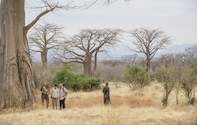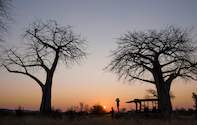Yet with all this space, natural abundance and the daily drama of wildlife, Ruaha National Park is little visited. At the time of writing, there are only five small safari camps, concentrated in the southeastern region near the Great Ruaha River.

Many were the times when we enjoyed a major wildlife spectacle with nobody else in attendance or, at most, one or two other game-drive vehicles.
Baobabs, known as the "tree of life" where they occur, are thought to live to 2,500 years old, maybe more - among the oldest living things on earth. Without peer they are the largest trees in Africa, trunks of large specimens attaining girths of 30 metres or more. The largest ever recorded measured a colossal 4 7 metre circumference.
However, being essentially succulents with an absence of real heartwood, they cannot be aged accurately. With their slightly creepy appearance when bare, they are the subject of myths. The most prevalent is that they were flung from the heavens by God in a rage and landed upside down in the ground, as punishment for assuming they could walk about at will like humans. When leafless the stout trunks and stubby branches do indeed resemble the root system of a tree that has been inverted.
A large Baobab tree can store as much as 100,000 litres of water in its fibrous body. Since these trees grow exclusively in seasonally arid regions, they become water tanks for elephants, which gouge out the moist, pulpy fibre. In extreme droughts, elephants can eat so much of my trunk as to, cause a tree to collapse, whereupon it is devoured in its entirety.
The bark of the Baobab tree contains a weak antibiotic, which is almost certainly the reason elephants, giraffes and other animals are drawn to chewing the trunk and branches. Since they have walked the African savanna, humans too have found many uses for the tree and its parts. The bark fibre renders rope and can be woven into the material. The seeds inside the velvety, coconut-like fruits are comprised almost entirely of cream of tartar, which for children is like natural sherbet. Even the leaves can be eaten as vegetable greens.
The seeds are highly nutritious, containing modest levels of 'carbohydrates, proteins and fats, as well as being a virtual multi-vitamin and mineral cocktail: about 50 percent is dietary fibre, 12 percent water, with high levels of vitamin C and thiamin.
Ancient Giants

At around 1,000 years old tree trunks tends to open out, forming natural reservoirs that are used by all manner of creatures - bees, tree agamas, snakes, birds, squirrels, bush babies and bats. In places very old trees become cavernous and apart from being the lairs of leopards and pythons, they have on occasion been used by humans as homes, jails and pubs.
Many of the older Baobabs in Ruaha National Park, as elsewhere, appear to have acne pocked bark, while others are very smooth. Closer examination reveals the pockmarks run in lines up the trunks. Now and again you will notice a wooden peg driven into a trunk, sometimes a row, or broken row of them: these are the ladders of wild honey collectors from a time before the area was declared a national park. A wild honey hive is a treasure trove in the African bush, often being owned by a hunter or clan.
The trees seem to know when the first rains are approaching and quickly produce their flowers. The delicate white flowers appear like lanterns hanging from the finger-like branches. White petals surround a cluster of pollen-saturated stamens, which last for only a few days and after they have dropped off, the first leaf sprouts appear.
The Baobab trees do go walk-about, after a fashion, on the reproductive prowl. Their pollen attracts flunering sunbirds during the day, and frugivorous bats at night. Seeing the trees massed on the grass plains of Ruaha national Park, it is easy to understand how indigenous people incorporated them into myths about giants, titans and gods. It would not be so surprising to peep out of your safari tent one night and see crowds of baobab trees going for a meander around.
There has always been great mystery and magic in the air of Africa, from which nobody is immune.
By David Bristow

 Jabali Ridge is ideal for guests seeking an authentic African safari experience in the Ruaha National Park in Tanzania....
Jabali Ridge is ideal for guests seeking an authentic African safari experience in the Ruaha National Park in Tanzania.... Ruaha National Park in Tanzania is part of the Rungwa-Kizigo-Muhesi ecosystem which covers 45 000 square kilometers. See Ruaha National Park...
Ruaha National Park in Tanzania is part of the Rungwa-Kizigo-Muhesi ecosystem which covers 45 000 square kilometers. See Ruaha National Park...